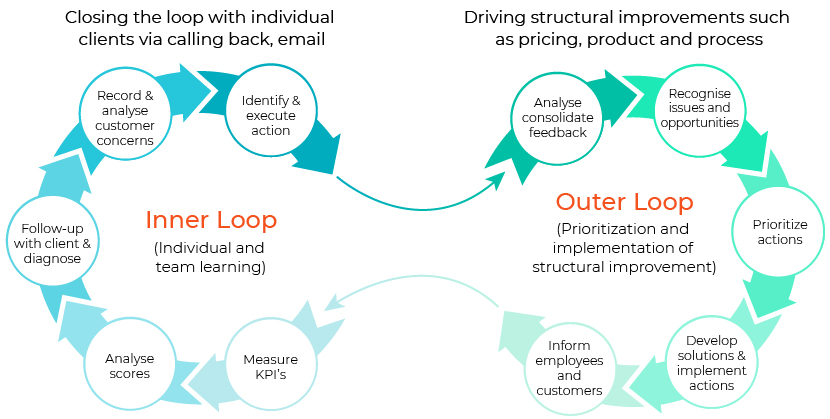Published on August 12, 2021 by Sanjay Malik
Unlocking organisational success with the Voice of the Customer programme (an 8-part series)
This is part 6 of 8 our comprehensive series of blogs on the Voice of Customer.
Stay tuned for more blogs.
So far in this series, we have seen how organisations can adopt VoC programmes and how these can make an impact across departments. In this blog, we focus on the process of acting on VoC feedback, generally referred to as “closing the loop”, which means much more than just responding to feedback. It outlines the strategy for customer communication, issue resolution, and follow-up and using customer insights to enhance the company’s product/service proposition. Organisations need to understand what closing the loop means and what it does not. A simple follow-up or response is not what is meant. Many organisations send automated thank-you notes when feedback is received, fix issues when they are highlighted in feedback or send a mass update email to customers – this is not what it means to close the loop.
Closing the loop involves making customers feel valued and aware that the organisation cares about their pain points and will listen to and act on their feedback. Customers who feel valued are likely to continue their association with such an organisation, boding well not only for customer retention but also for revenue growth through positive word of mouth.
Modern customer experience (CX) platforms provide alert creation (where, depending on the feedback score, an email is sent to the individuals/departments concerned) and case management systems (action tracking) integrated with surveys to ensure smooth processes across an organisation. Organisations typically implement a two-stage process to close the loop. These two stages or loops work together and feed information to each other. The first loop is called the inner loop, also referred to as a customer feedback loop or an operational loop; the second loop is called the outer loop, also referred to as an enterprise improvement loop or a structural loop.

Inner loop
The inner loop promotes individual learning. It allows front-line employees (such as advisers and customer representatives) to respond to customer feedback and take appropriate action for each response. The process should facilitate a flexible and effective conversation with customers, with no organisational barrier to passing on the information to/resolving the issue in collaboration with other departments.
The typical process includes following up with the customer (preferably via phone) but not before being adequately prepared with knowledge of the customer's current situation/issue. The conversation needs to be empathetic but also transparent, as it may not be practical to address all pain points. Maintaining transparency and honesty, and providing reasonable explanations for saying no would ease customer concern considerably.
For the next steps, organisations should again take a realistic and practical approach to accepting requests and create a prioritisation queue. They should also focus on getting the maximum information from the client about the issues faced so it is easier to analyse and address them. A summary of each conversation and next steps should be properly logged in the system.
Outer loop
The outer loop is an enterprise-level process that aims to make systemic changes based on root-cause analysis and the evaluation of broader datasets (KPIs, other metrics and detraction themes). This is where management implements structural improvements at the company level (such as changes to products, pricing, policy and customer support) and evaluates their effectiveness. Inputs for the outer loop are fed from the outcome (analysis) of individual feedback responses in the inner loop.
For example, detractor feedback analysis reveals that long waiting times on customer support calls impact a company’s key performance metrics (such as CSAT scores and NPS). Based on these findings, the company increases its headcount providing customer support and provides customers with self-help tools to enhance the customer experience.
The outer loop is important because it shows the feedback has been heard and the company is proactively taking steps to enhance its services and offerings. However, this should not be seen just as addressing customer concerns; it is the most authentic route to developing the products and services that customers actually want or face problems with when using them in the real world.
Customer feedback is also not only about complaints; it includes positive feedback or suggestions for improvement. Organisations could leverage this information to generate new revenue opportunities, increase customer engagement, enhance loyalty and gain references. Engaging promoters on this front would help organisations build stronger relationships, assuring them that they are not taken for granted. Similarly, organisations can engage with passives to stop their churn. While it is comparatively straightforward to respond to promoters, passives or detractors, there is usually a large number of customers who do not respond to surveys. Proactive organisations would treat such customers as detractors and try to reach out to them personally as well, thus covering the entire spectrum of customers.
In the next part of this series, we will see in more detail how organisations convert passives and detractors into promoters.
References:
Closing the Customer Feedback Loop: Turn Insights into Action, Retently, Jun 2018
Customer Feedback Loop: What is it and how to close it, Lumoa, Oct 2020
What Is the Net Promoter System?, Bain
7 Best Practices for Closing the Customer Feedback Loop, USERVOICE, Aug 2019
What is Closed-Loop Customer Experience Management?, Qualtrics
Tags:
What's your view?
About the Author
Sanjay is a part of Strategy Research team at Acuity Knowledge Partners, with experience across domains such as financial services, fin-tech and consulting, besides working on bespoke projects in the strategy domain. He has worked on projects involving competitive intelligence, market entry & growth strategy, market sizing, industry profiles and benchmarking studies
He is responsible for project execution and delivery, besides working closely with client teams on research tasks and managing source references across projects. He has exposure and knowledge of proprietary databases such as FactSet, Hoovers, Nexis, Bloomberg, and Thomson
He has an overall experience of 6+ years. Prior to Acuity Knowledge Partners, he..Show More
Like the way we think?
Next time we post something new, we'll send it to your inbox









